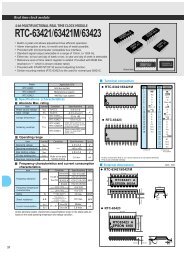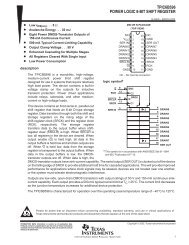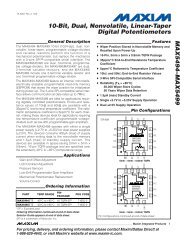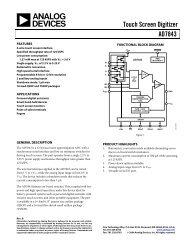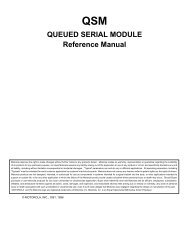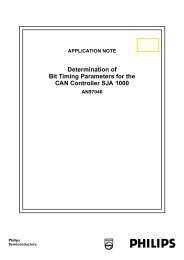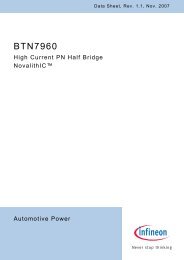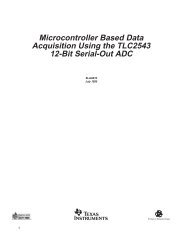Create successful ePaper yourself
Turn your PDF publications into a flip-book with our unique Google optimized e-Paper software.
Philips Semiconductors Preliminary <strong>User</strong> <strong>Manual</strong><br />
ARM-based Microcontroller<br />
CRYSTAL OSCILLATOR<br />
<strong>LPC2131</strong>/<strong>2132</strong>/<strong>2138</strong><br />
While an input signal of 50-50 duty cycle within a frequency range from 1 MHz to 50 MHz can be used by <strong>LPC2131</strong>/<strong>2132</strong>/<strong>2138</strong><br />
if supplied to its input XTAL1 pin, this microcontroller’s onboard oscillator circuit supports external crystals in the range of 1 MHz<br />
to 30 MHz only. If on-chip PLL system or boot-loader is used, input clock frequency is limited to exclusive range of 10 MHz to 25<br />
MHz.<br />
The oscillator output frequency is called F osc and the ARM processor clock frequency is referred to as cclk for purposes of rate<br />
equations, etc. elsewhere in this document. F osc and cclk are the same value unless the PLL is running and connected. Refer to<br />
the PLL description in this chapter for details and frequency limitations.<br />
Onboard oscillator in <strong>LPC2131</strong>/<strong>2132</strong>/<strong>2138</strong> can operate in one of two modes: slave mode and oscillation mode.<br />
In slave mode the input clock signal should be coupled by means of a capacitor of 100 pF (Cc in Figure 7, drawing a), with an<br />
amplitude of at least 200 mVrms. X2 pin in this configuration can be left not connected. If slave mode is selected, F osc signal of<br />
50-50 duty cycle can range from 1 MHz to 50 MHz.<br />
External components and models used in oscillation mode are shown in Figure 7, drawings b and c, and in Table 6. Since the<br />
feedback resistance is integrated on chip, only a crystal and the capacitances C X1 and C X2 need to be connected externally in<br />
case of fundamental mode oscillation (the fundamental frequency is represented by L, C L and R S ). Capacitance Cp in Figure 7,<br />
drawing c, represents the parallel package capacitance and should not be larger than 7 pF. Parameters F C , C L , R S and C P are<br />
supplied by the crystal manufacturer.<br />
Choosing an oscillation mode as an on-board oscillator mode of operation limits F osc clock selection to 1 MHz to 30 MHz.<br />
<strong>LPC2131</strong>/<strong>2132</strong>/<strong>2138</strong><br />
X1 X2<br />
C C<br />
Clock<br />
Figure 7: Oscillator modes and models: a) slave mode of operation, b) oscillation mode of operation,<br />
c) external crystal model used for C X1/X2 evaluation<br />
Table 6: Recommended values for C X1/X2 in oscillation mode (crystal and external components parameters)<br />
Fundamental Oscillation<br />
Frequency F C<br />
1 - 5 MHz<br />
<strong>LPC2131</strong>/<strong>2132</strong>/<strong>2138</strong><br />
C X1<br />
X1 X2<br />
Xtal<br />
a) b) c)<br />
Crystal Load<br />
Capacitance C L<br />
Max. Crystal Series<br />
Resistance R S<br />
External Load<br />
Capacitors C X1 , C X2<br />
10 pF n.a. n.a.<br />
20 pF n.a. n.a.<br />
30 pF < 300 : 58 pF, 58 pF<br />
System Control Block 31 November 22, 2004<br />
C X2<br />
<br />
L<br />
C L<br />
R S<br />
C P




